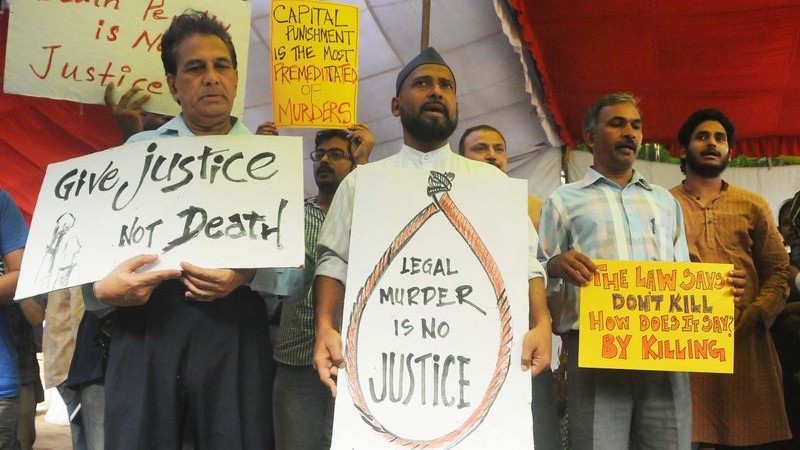
Indian social activists hold placards during a protest against the hanging of 1993 Mumbai blast convict Yakub Memon, in the Capital. Image by Himanshu Sharma. Copyright Demotix (30/7/2015)
Last month, three Indian news channels were issued separate show-cause notices by the government. ABP News, NDTV 24×7 and Aaj Tak allegedly showed disrespect to the judiciary and the president of India by airing content criticizing the decision to execute Yakub Menon, convicted of the 1993 Mumbai bombings.
The Ministry of Information and Broadcasting has asked the channels to explain why the government should take no action against them for broadcasting the controversial content. The ministry even threatened to cancel their licenses.
Shocking & upsetting moves by #Modi Govt to curb media freedom: 1st, notices to 3 TV channels; now, troubling All India Radio for criticism
— Kaushal K Vidyarthee (@vidyarthee) August 13, 2015
The content in question included phone-in interviews with Chhotta Shakeel, a Mumbai underworld figure who is believed to be one of the masterminds behind the bombings. In his interview, Shakeel claimed that Yakub Menon was innocent and that his execution was a “legal murder”.
The ministry's actions were viewed in many parts of the media as questionable and a form of censorship. But others disagreed, taking issue with the sympathetic tone that they perceived in the media's reporting on Menon's case and execution.
@rupasubramanya @madhukishwar since India media is still not mature & misuses freedom of speech, it needs to be regulated. Hurts nation
— Akshay Ohri (@akshayohri) August 8, 2015
In the op-ed at Business Standard, Jency Jacob claimed the media had “done irreparable damage” by portraying Memon as innocent to advance their own anti-death penalty agenda. Jacob also argued that media had acted irresponsibly when it broadcast Shakeel's warning that there will be “consequences” for Memon's death. It's all part of why Indian audiences are distrustful of media, he said:
Whenever any attempt is made by the government to regulate the media, the industry is up in arms, and rightly so. But when you lose the trust of your readers and viewers, you pave the way for the government to bring in curbs. That most newsrooms, high on the ‘exclusive’ interview with a fugitive living overseas, are not able to perceive this distrust is a reflection of the disconnect today’s media has with reality.
‘Ostrich mentality’
Media sins aside, press freedom in India is indeed lacking. India ranks a dismal 136 out of 180 countries in the Reporters Without Borders World Press Freedom Index. In March, the Economic Times reported that the Narendra Modi's administration is planning to spend Rs200 crore (US $32 million) to set up a new journalism university modeled on Beijing’s government-run Communication University of China. It is needless to point out that such a journalism university and its products would be a government mouthpiece.
One doesn't have to look too far back in history to find examples of officials meddling with the press and other forms of media (including social media). Banning online access and distribution of BBC’s “India’s Daughter“, a documentary on the Nirbhaya rape case, was one such instance in which India’s online censorship looked inspired from China. The documentary was banned from release in India and then removed from YouTube too at the request of the Indian government.
We have this Ostrich Mentality Banning #IndiasDaughter is like putting your head in the sand so no one can see me..
— anurag basu (@basuanurag) March 5, 2015
There is an evil out there, an evil which is stamping out all free speech and silencing independent journalists: journalists unite!
— Sagarika Ghose (@sagarikaghose) February 7, 2014
Update Sept. 1, 2015: Recently, the Indian censor board refused to certify a documentary based on the 2014 election campaign in Varanasi, saying that it “pokes fun” at the Indian Prime Minister Narendra Modi. The documentary which shows poll rallies and public speeches given by several candidates from the constituency at the time, was rejected by the censor board as they felt that the contents of the documentary showed “Modi in a bad light and mocked him”.
In June, journalist Jagendra Singh was killed in northern India after he was set on fire, allegedly by local policemen and goons under the direction of the Uttar Pradesh state minister for dairy development, for writing Facebook posts accusing the minster of having links to corruption.
More recently, the Department of Telecommunication issued a secret order to ban 857 websites thought to contain pornographic content. After public outrage, authorities announced that the ban was temporary, except for sites that contained child abuse or pornography.
India takes another historic step going prehistoric. Proud to be an Indian! #PornBan
— Priyank Sharma (@priyank_sharma) August 3, 2015
India prides itself as the world’s largest democracy. If a free press is truly the cornerstone of democracy, it appears that India still has some work to do to live up to that title.







1 comment